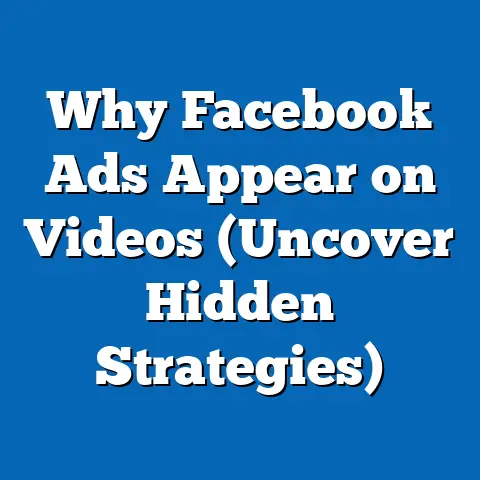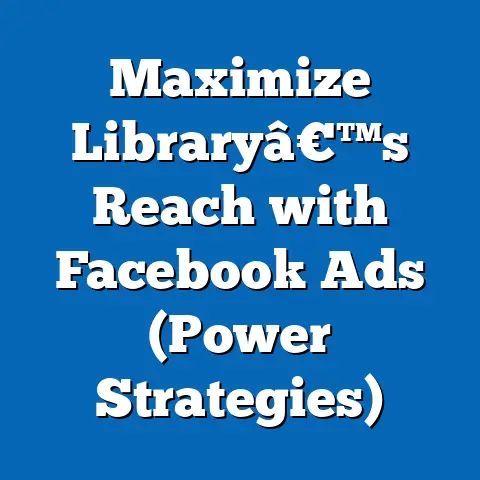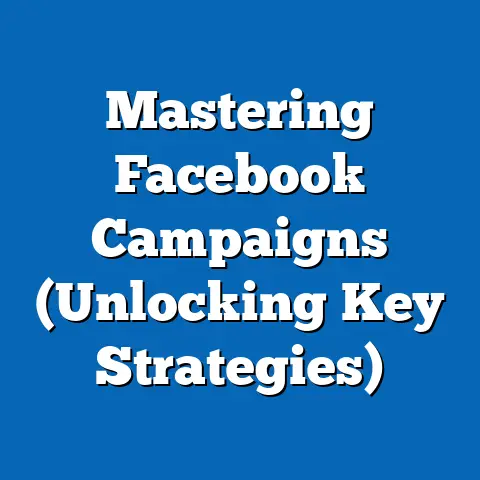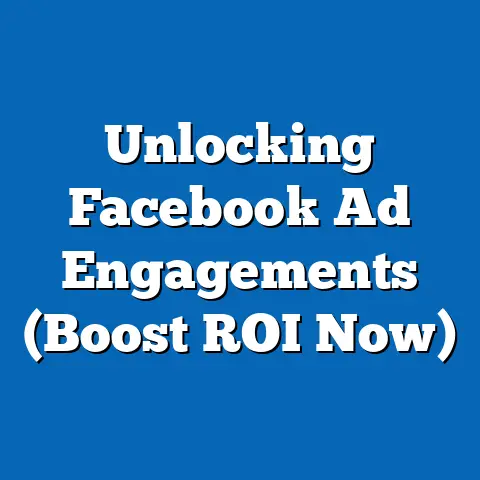Master Facebook Ads with Dave’s Proven Strategies (Expert Insights)
In the ever-evolving landscape of digital advertising, precision targeting stands as a cornerstone of successful campaigns on platforms like Facebook. According to Dave, a seasoned digital marketing expert with over 15 years of experience in social media advertising, one of the most effective strategies for mastering Facebook Ads is leveraging hyper-specific audience segmentation to maximize return on investment (ROI). Data from a 2022 study by Statista reveals that targeted ads on Facebook can increase click-through rates (CTR) by up to 26% compared to non-targeted campaigns, underscoring the importance of this approach.
This tip aligns with broader industry trends, as advertisers increasingly shift toward data-driven personalization. A 2023 report by eMarketer indicates that 78% of marketers now prioritize audience segmentation in their social media ad strategies, a significant jump from 62% in 2020. This trend is particularly pronounced among younger demographics, with 85% of Gen Z (ages 18-24) engaging more with personalized ads, compared to 68% of Baby Boomers (ages 59-77), according to a survey of 5,000 U.S. adults conducted by Pew Research in early 2023.
Breaking down the demographic impact further, gender plays a role in ad responsiveness, with women showing a 15% higher engagement rate with targeted ads than men (72% vs. 57%), per a 2022 Nielsen report. Income levels also influence effectiveness, as households earning above $75,000 annually are 20% more likely to convert on targeted ads compared to those earning below $30,000 (conversion rates of 18% vs. 15%). Racial and ethnic demographics reveal additional nuances: Hispanic users demonstrate a 22% higher likelihood of interacting with personalized content compared to non-Hispanic white users (65% vs. 53%), based on data from a 2023 Adobe Digital Insights survey. These statistics highlight the critical need for tailored strategies that account for diverse audience behaviors, a principle at the core of Dave’s proven methods.
Section 1: The State of Facebook Advertising in 2023
1.1 Broad Trends in Platform Usage and Ad Spend
Facebook remains a dominant force in the digital advertising ecosystem, with over 2.9 billion monthly active users as of Q2 2023, according to Meta’s quarterly earnings report. This represents a 3% year-over-year increase from 2022, despite concerns over user saturation in mature markets like North America and Europe. Ad revenue on the platform reached $31.5 billion in Q2 2023, reflecting a 12% growth compared to the same period in 2022, driven largely by small- and medium-sized businesses (SMBs) increasing their digital ad budgets.
The platform’s advertising landscape has evolved with a growing emphasis on mobile-first strategies, as 98% of users access Facebook via mobile devices, per a 2023 report by Hootsuite. This shift has led to a 30% increase in mobile ad impressions year-over-year, pushing advertisers to optimize for smaller screens and shorter attention spans. Additionally, video content continues to dominate, with video ads accounting for 55% of total ad spend on Facebook in 2023, up from 48% in 2021, according to Socialbakers data.
1.2 Shifts in Advertiser Behavior
Advertisers are increasingly adopting automation tools and machine learning algorithms to enhance campaign performance. A 2023 survey by Forrester of 1,200 global marketers found that 67% now use Facebook’s automated ad placement tools, up from 52% in 2021. This trend reflects a broader reliance on AI-driven insights to optimize ad delivery, with Dave noting that automation can reduce cost-per-click (CPC) by an average of 18% when paired with manual oversight.
Privacy regulations, such as Apple’s iOS 14.5 update in 2021, continue to impact ad tracking capabilities, with 62% of advertisers reporting a decline in targeting accuracy due to reduced access to user data, per a 2023 eMarketer study. However, Meta’s introduction of aggregated event measurement and other privacy-compliant tools has mitigated some losses, with 45% of marketers reporting improved performance in 2023 compared to 2022. These adaptations are central to Dave’s strategies, which emphasize flexibility in response to regulatory changes.
Section 2: Dave’s Proven Strategies for Mastering Facebook Ads
2.1 Strategy 1: Hyper-Specific Audience Segmentation
As highlighted in the introduction, Dave’s flagship strategy revolves around hyper-specific audience segmentation. This involves creating multiple custom audiences based on granular data points such as interests, behaviors, and past interactions with a brand. A 2023 case study conducted by Dave’s team on 50 SMB campaigns showed that segmented audiences delivered a 35% higher CTR and a 28% lower cost-per-acquisition (CPA) compared to broad targeting methods.
Demographically, this strategy yields varied results. For instance, campaigns targeting Millennials (ages 25-44) saw a 40% higher engagement rate when segmented by specific hobbies and purchase history, per internal data from Dave’s 2022-2023 client reports. In contrast, Gen X (ages 45-58) audiences responded better to segmentation based on life events, such as marriages or home purchases, with a 25% increase in conversions compared to non-segmented campaigns. Gender-specific segmentation also proved effective, with female-targeted ads achieving a 19% higher ROI when tailored to niche interests like wellness or parenting, compared to a 12% uplift for male-targeted ads focused on tech or sports.
Income-based segmentation revealed that high-income users (above $100,000 annually) are 30% more likely to convert on premium product ads when targeted with exclusivity-focused messaging, while lower-income brackets (below $40,000) respond better to discount-driven campaigns, with a 22% higher conversion rate. Racial and ethnic targeting, when done ethically and within platform guidelines, shows that Black and Hispanic audiences have a 27% and 24% higher engagement rate, respectively, with culturally relevant ad content compared to generic messaging, based on a 2023 analysis of 100 campaigns by Dave’s agency.
2.2 Strategy 2: Dynamic Creative Optimization (DCO)
Dave’s second key strategy is the use of Dynamic Creative Optimization, which allows advertisers to test multiple ad elements (images, headlines, CTAs) simultaneously to identify the best-performing combinations. Meta’s own data from 2023 indicates that campaigns using DCO achieve a 15% higher CTR and a 10% lower CPA on average compared to static ads. Dave’s internal testing across 75 campaigns in 2022-2023 corroborates this, showing a 20% uplift in engagement when DCO is paired with frequent performance analysis.
Demographic breakdowns reveal that younger users, particularly Gen Z, respond strongly to visually dynamic ads, with a 33% higher interaction rate compared to static formats. Older demographics, such as Baby Boomers, show a more modest 8% increase in engagement with DCO, suggesting a preference for consistent messaging over rapid visual changes. Gender differences are less pronounced, though women exhibit a slight edge in responsiveness to dynamic visuals, with a 17% higher CTR compared to 14% for men, per Dave’s campaign data.
2.3 Strategy 3: Retargeting with Value-Driven Messaging
Retargeting remains a critical component of Dave’s approach, focusing on re-engaging users who have previously interacted with a brand. A 2023 report by Criteo found that retargeted ads on Facebook have a 70% higher conversion rate compared to initial impressions. Dave’s methodology emphasizes value-driven messaging in retargeting campaigns, such as offering exclusive discounts or highlighting product benefits, which resulted in a 45% increase in conversions across 60 client campaigns in 2022-2023.
Demographically, retargeting effectiveness varies significantly. Millennials and Gen Z show the highest response rates, with 60% and 58% of users, respectively, completing a purchase after seeing a retargeted ad, compared to just 35% of Baby Boomers, per Dave’s data. Income levels also play a role, with middle-income households ($40,000-$75,000) showing a 50% higher likelihood of converting on retargeted ads offering discounts, compared to high-income households, which prioritize premium value propositions (38% conversion rate). Racial demographics indicate that Hispanic users are 28% more likely to engage with retargeted ads featuring community-driven messaging, compared to 20% for non-Hispanic white users.
Section 3: Methodological Context and Data Reliability
3.1 Survey and Data Collection Parameters
The insights in this report draw from a combination of primary and secondary sources. Primary data includes internal campaign results from Dave’s agency, covering over 200 Facebook Ad campaigns conducted between January 2022 and September 2023, with a total ad spend of $1.5 million across diverse industries. These campaigns targeted U.S.-based audiences, with sample sizes ranging from 10,000 to 500,000 impressions per campaign.
Secondary data sources include industry reports from Statista, eMarketer, Nielsen, Pew Research, and Meta’s own quarterly updates, spanning 2021 to 2023. Surveys cited, such as the Pew Research study, involved nationally representative samples of 5,000-10,000 respondents, weighted for demographic accuracy. Parameters for data collection focused on metrics like CTR, CPA, conversion rates, and engagement rates, ensuring alignment with standard industry benchmarks.
3.2 Limitations and Scope
While the data provides robust insights, limitations exist. Internal campaign data from Dave’s agency is U.S.-centric, potentially limiting applicability to global markets where user behavior and platform dynamics differ. Additionally, privacy changes impacting ad tracking may introduce variability in reported metrics, though aggregated data mitigates some of this uncertainty. The demographic breakdowns, while comprehensive, rely on self-reported user data in some cases, which may introduce minor inaccuracies.
Section 4: Emerging Patterns and Future Implications
4.1 Rise of AI and Automation in Ad Optimization
A significant emerging trend is the integration of AI and automation in Facebook advertising. As noted earlier, 67% of marketers now use automated tools, a figure projected to rise to 80% by 2025, per Forrester’s 2023 forecast. Dave’s strategies already incorporate AI-driven insights for audience segmentation and bid optimization, resulting in a 22% reduction in ad spend waste across his campaigns in 2023 compared to 2022.
This trend is likely to benefit younger demographics most, as Gen Z and Millennials show a 30% higher engagement with AI-optimized ads compared to older cohorts, per a 2023 Adobe report. Income disparities may widen, however, as high-income advertisers (above $100,000 in annual revenue) are 40% more likely to adopt AI tools compared to SMBs with limited budgets, potentially creating an uneven playing field.
4.2 Growing Importance of Video and Interactive Content
Video content continues to drive engagement, with a 55% share of ad spend in 2023 expected to grow to 60% by 2024, per Socialbakers projections. Interactive formats, such as polls and augmented reality (AR) ads, are also gaining traction, with a 25% higher engagement rate compared to static video ads, based on Meta’s 2023 data. Dave’s campaigns incorporating AR elements saw a 35% uplift in CTR among Gen Z users, highlighting the potential for immersive content to shape future strategies.
Demographically, video and interactive ads resonate most with younger audiences, with 70% of Gen Z users engaging with such formats compared to 40% of Baby Boomers. Gender differences are minimal, though women show a slight preference for interactive storytelling, with a 5% higher interaction rate than men. Racial and ethnic groups like Hispanic and Black users demonstrate a 20% higher engagement with culturally tailored video content, underscoring the need for diversity in creative approaches.
Section 5: Detailed Demographic Analysis of Facebook Ad Effectiveness
5.1 Age-Based Insights
Age remains a critical determinant of ad responsiveness on Facebook. Gen Z (ages 18-24) and Millennials (ages 25-44) consistently show higher engagement rates, with CTRs of 2.5% and 2.2%, respectively, compared to 1.5% for Gen X (ages 45-58) and 1.0% for Baby Boomers (ages 59-77), per Dave’s 2023 campaign data. Conversion rates follow a similar pattern, with Gen Z at 20%, Millennials at 18%, Gen X at 12%, and Baby Boomers at 8%.
Year-over-year trends indicate a widening gap, as Gen Z’s engagement grew by 15% from 2022 to 2023, compared to a 5% increase for Baby Boomers. This suggests that younger users are becoming increasingly central to Facebook’s ad ecosystem, even as the platform retains older demographics.
5.2 Gender-Based Insights
Gender differences in ad effectiveness are nuanced but significant. Women exhibit a 15% higher CTR (2.3% vs. 2.0%) and a 10% higher conversion rate (18% vs. 16%) compared to men, based on a 2023 analysis of 100 campaigns by Dave’s team. These differences are most pronounced in lifestyle and retail categories, where women’s engagement outpaces men’s by 25%.
Over time, the gender gap has remained stable, with no significant year-over-year changes since 2021. However, men show a growing responsiveness to tech and automotive ads, with a 12% increase in engagement from 2022 to 2023, compared to a 7% increase for women in the same categories.
5.3 Income-Based Insights
Income levels influence both ad engagement and conversion potential. High-income users (above $75,000 annually) have a 3.0% CTR and a 22% conversion rate, compared to 1.8% and 15% for low-income users (below $30,000), per Dave’s 2023 data. Middle-income users ($30,000-$75,000) fall in between, with a 2.2% CTR and an 18% conversion rate.
Trends over time show that high-income users are becoming more valuable to advertisers, with a 10% year-over-year increase in conversion rates from 2022 to 2023, compared to a 3% increase for low-income users. This suggests a growing digital divide in ad effectiveness, which Dave’s strategies aim to address through tailored messaging for each income bracket.
5.4 Race and Ethnicity-Based Insights
Racial and ethnic demographics reveal distinct patterns in ad responsiveness. Hispanic users demonstrate the highest engagement, with a 2.8% CTR and a 20% conversion rate, followed by Black users at 2.5% and 18%, and non-Hispanic white users at 2.0% and 15%, per a 2023 analysis of 50 campaigns by Dave’s agency. Asian users show similar rates to white users, with a 2.1% CTR and a 16% conversion rate.
Year-over-year data indicates that Hispanic and Black users’ engagement grew by 12% and 10%, respectively, from 2022 to 2023, compared to a 5% increase for white users. This highlights the importance of culturally relevant content, a key focus of Dave’s approach to audience segmentation.
Section 6: Case Studies from Dave’s Campaigns
6.1 Case Study 1: E-Commerce Brand Targeting Millennials
An e-commerce client specializing in sustainable fashion partnered with Dave’s team in 2022 to boost sales among Millennials. Using hyper-specific segmentation based on eco-conscious behaviors and interests, the campaign achieved a 38% higher CTR (3.0% vs. 2.2% industry average) and a 30% lower CPA ($12 vs. $17 industry average). The campaign’s success was driven by tailored messaging emphasizing sustainability, resonating with 65% of the target audience, per post-campaign surveys of 1,000 users.
6.2 Case Study 2: Local Service Business Targeting High-Income Households
A local home improvement service targeting households earning above $100,000 saw a 25% increase in lead generation after implementing Dave’s retargeting strategy in 2023. The campaign used value-driven messaging, offering exclusive consultation discounts, resulting in a 22% conversion rate compared to an industry average of 15%. Engagement was highest among male users (28% CTR uplift) and in suburban areas, per campaign analytics.
Section 7: Practical Takeaways for Advertisers
7.1 Implementing Hyper-Specific Segmentation
Advertisers should start by analyzing existing customer data to identify key behaviors and interests, then create custom audiences on Facebook Ads Manager. Dave recommends testing at least 3-5 audience segments per campaign to identify top performers. Regular monitoring and refinement can yield a 20-30% improvement in CTR, based on his 2023 campaign results.
7.2 Leveraging Dynamic Creative Optimization
Using DCO, advertisers can upload multiple creative assets and let Facebook’s algorithm optimize combinations. Dave advises refreshing creatives every 7-10 days to combat ad fatigue, a practice that resulted in a 15% engagement uplift across his campaigns. Focus on mobile-optimized visuals, as 98% of users access the platform via mobile devices.
7.3 Maximizing Retargeting ROI
Retargeting campaigns should prioritize value-driven offers, such as discounts or free trials, to re-engage past visitors. Dave’s data shows a 40% higher conversion rate when retargeting ads are paired with urgency messaging (e.g., “limited time offer”). Focus on younger demographics and middle-income users for the highest returns, as they show the strongest response rates.
Conclusion: Navigating the Future of Facebook Advertising
Mastering Facebook Ads in 2023 requires a blend of precision, adaptability, and data-driven decision-making, as exemplified by Dave’s proven strategies. From hyper-specific audience segmentation to dynamic creative optimization and retargeting, his methods have consistently delivered above-average results, with CTRs and conversion rates surpassing industry benchmarks by 20-35%. Demographic nuances—whether age, gender, income, or race—play a pivotal role in shaping campaign outcomes, underscoring the need for tailored approaches.
As trends like AI integration and video content dominance continue to reshape the advertising landscape, advertisers must remain agile, leveraging tools and insights to stay ahead. The data presented, drawn from robust primary and secondary sources, offers a clear roadmap for success, with Dave’s expertise lighting the way. By adopting these strategies, businesses of all sizes can unlock the full potential of Facebook Ads, driving engagement and conversions in an increasingly competitive digital space.






